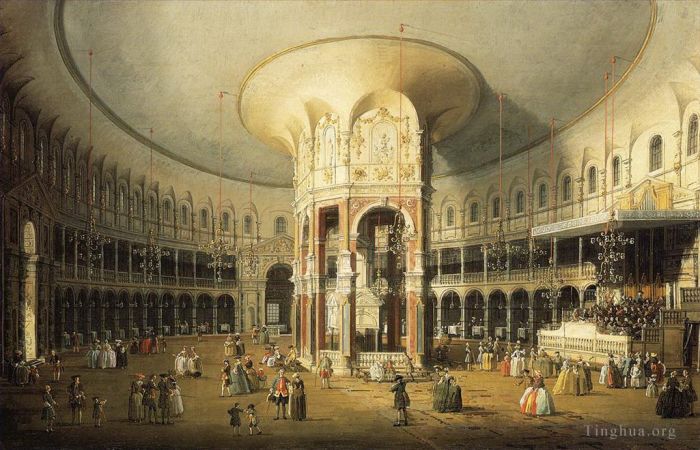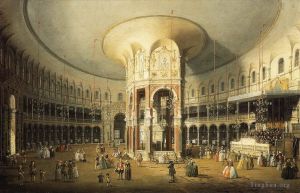London Interior of the Rotunda at Ranelagh
Canaletto
- Price: Price on Request
- Art Type: Oil Painting
- Size:
- English Comments: 0
- International Comments: 0
- Creating Date:
- Introduction and Works of Canaletto >>
Work Overview
- The Interior of the Rotunda, Ranelagh Gardens (London: Interior of the Rotunda at Ranelagh)
Canaletto
Date: c.1751
Style: Rococo
Genre: veduta
Media: oil, canvas
47 x 75.6 cm
Location: Private Collection
centrepiece to Ranelagh Gardens which opened in 1742 to great acclaim. Ranelagh was a public pleasure garden, similar to the older Vauxhall Gardens, and situated in Chelsea (then outside London). The rotunda was designed by William Jones and included a central support with a chimney and fireplace for use in winter. In 1765, the nine-year-old Wolfgang Amadeus Mozart performed in the rotunda. This is one of two interior views of the rotunda painted by Canaletto, the other being in the National Gallery, London.
Ranelagh Gardens (/ˈrænɪlə/; alternative spellings include Ranelegh and Ranleigh, the latter reflecting the English pronunciation[clarification needed]) were public pleasure gardens located in Chelsea, then just outside London, England in the 18th century.
The centrepiece of Ranelagh was a rococo rotunda, which figured prominently in views of Ranelagh Gardens taken from the river. It had a diameter of 120 feet (37 metres) and was designed by William Jones, a surveyor to the East India Company. The central support housed a chimney and fireplaces for use in winter. From its opening, the Rotunda at Ranelagh Gardens was an important venue for musical concerts. In 1765, the nine-year-old Mozart performed in this showpiece. Canaletto painted the gardens, and painted the interior of the Rotunda twice, for different patrons.[2] The rotunda was closed in 1803 and demolished two years later. The organ was moved to All Saints Church, Evesham.
The inscription in Italian on the back of the original canvas states that the picture was painted in London in 1754 for the artist's patron Thomas Hollis, and that the view was unique in the artist's work. The Rotunda in Ranelagh Gardens, Chelsea, was erected as a public venue for various entertainments in 1741 and closed in 1803. Musical concerts were held and Mozart performed there in 1764.
- Copyright Statement:
All the reproduction of any forms about this work unauthorized by Singing Palette including images, texts and so on will be deemed to be violating the Copyright Laws.
To cite this webpage, please link back here.
- >> English Comments
- >> Chinese Comments
- >> French Comments
- >> German Comments
- >>Report
- Capriccio with ruins and porta portello in padua
- The women s regaton the grand canal
- The campo di rialto
- The Eastern Facade Of Warwick Castle
- Riva degli Schiavoni west side
- The piazzetta towards san giorgio maggiore
- Doge Palace
- Santa Maria Zobenigo
- Grand Canal
- San Giacomo Di Rialto
- The Piazzetta
- Capriccio with classical ruins and buildings
- Grand Canal From Santa Maria Della Carita To The Bacino Di San Marco
- Basilica di vecenza and the ponte de rialto
- Capriccio of a round church with an elaborate gothic portico in a piazza a palladian piazza and 1755
- Piazza San Marco Venice (Piazza San Marco with the Basilica)
- The Nave of San Marco looking East (San Marco the Interior)
- Warwick castle
- The Bucintoro Returning To The Molo On Ascension Day
- A Regatta on the Grand Canal
- Venice Viewed from the San Giorgio Maggiore
- View of the Ducal Palace
- Piazza san marco looking east
- The Bacino di San Marco on Ascension Day
- View Of the Entrance To The Arsenal
- Dolo On The Brenta Venetian Venice
- The Molo Looking West
- Palazzo Ducale and the Piazza di San Marco
- Grand Canal The Rialto Bridge From The South
- Scala dei giganti 1765
- The Riva Degli Schiavoni
- Rio Dei Mendicanti
- The interior of henry vii chapel in westminster abbey
- View of the grand walk vauxhall gardens with the orchestra pavilion the organ house the turkish
- Perspective View with Portico
- Stonemasons Yard
- View of the Bacino di San Marco St Marks Basin
- Perspective with a portico 1765
- The thames with st pauls cathedral 1746
- Piazza San Marco 1730
- Reception Of The Ambassador In The Doges Palace
- Dolo on the brenta
- Return Of The Bucentoro To The Molo On Ascension Day
- The chapel of eton college 1747
- The Grand Canal From Rialto Toward The North
- The Grand Canal with the Rialto Bridge in the Background
- View Of Campo Santi Apostoli
- Perspective view with portico
- Capriccio of the grand canal with an imaginary rialto bridge and other buildings
- London Interior of the Rotunda at Ranelagh
- The Grand Canal looking East from Campo San Vio towards the Bacino
- The Fonteghetto Della Farina
- The Piazzetta towards S. Giorgio Maggiore
- The thames and the city of london from richmond house 1746
- Campo san rocco
- Night time celebration outside the church of san pietro di castello
- The Stonemasons Yard
- Canal Giovanni Antonio View Of The Grand Canal And Santa Maria Della Salute With Boats And Figure
- The Piazzetta towards Santa Maria della Salute
- Piazza San Marco The Clocktower
- Capriccio of a renaissance triumphal arch seen from the portico of a palace 1755
- Bacino di San Marco St Marks Basin
- San francesco della vigna church and campo
- Entrance To The Grand Canal Looking East
- Alnwick castle
- Piazza San Marco Looking Southeast
- Westminster abbey with a procession of knights of the bath 1749
- CANALETTO Grand Canal Looking Northeast From Palazo Balbi Toward The Rial to Bridge
- The Feast Day of St Roch
- Arrival of the French Ambassador in Venice
- CANALETTO Grand Canal Looking East From The Campo San Vio
- Capriccio Ruins And Classic Buildings
- The Entrance to the Grand Canal Venice
- A Regatta on the Grand Canal
- English Landscape Capriccio with a Column
- The dogana in Venice (Punta della Dogana in Venice)
- Santi Giovanni E Paolo And The Scuola Di San Marco 1726
- Campo santa maria formosa
- The Piazza San Marco in Venice
- San Cristoforo San Michele and Murano from the Fondamenta Nuove Venice
- The Grand Canal with Santa Maria della Salute looking East towards the Bacino
- Rome the arch of constantine 1742
- Santi Giovanni e Paolo and the Scuola de San Marco
- The Grand Canal near the Ponte di Rialto
- Venice Piazza San Marco and the Colonnade of the Procuratie Nuove









 Singing Palette
Singing Palette